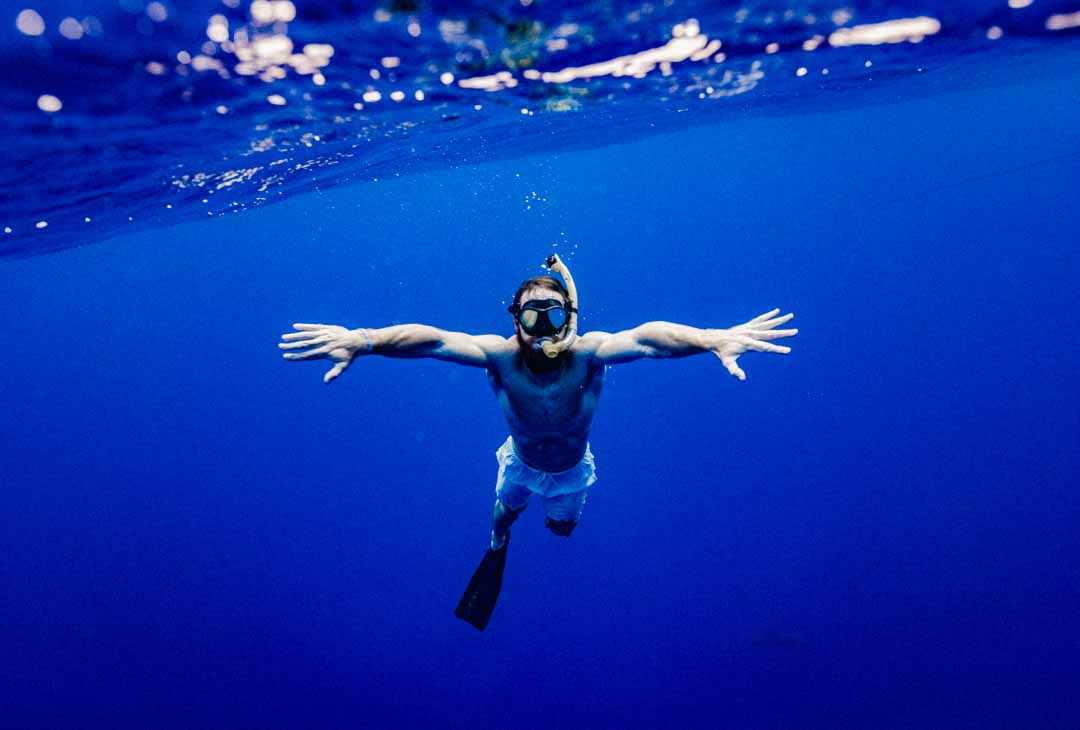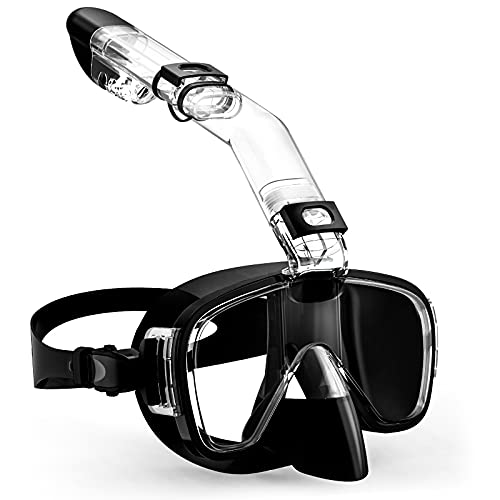Before we get into the specifics regarding the best snorkel mask of 2023, first let’s take a step back to make sure that you are buying the best snorkel mask suited to your intended use. Because there’s some cross over between mask styles and the activities that they can be used for, it’s a good idea to think about the activities you might want to do. The best snorkel masks can sometimes be used for other activities. Here’s a summary to help.
BEST SNORKEL MASK IN 2023
- SWIMSTAR Snorkel Set
- GREATEVER G3 Snorkel Mask
- GREATEVER Foldable Panoramic View Snorkel Mask
- PROMATE Scope Snorkel Mask
- WILDHORN OUTFITTERS Seaview V2 Full Face Snorkel Mask
- CRESSI F1
- CRESSI Nano 2
- MARES Pirate Junior
- PHANTOM AQUATICS Panorama
- CRESSI Duke
- SCUBAPRO Zoom Evo
- HEAD Sport Sea Vision Full Face
ALL THE SNORKEL MASK THAT WE TESTED
SWIMSTAR Snorkel Set
General Impression
The Swimstar Snorkel Set is the ideal balance between stylish and functional. With tempered glass lenses and a double silicone skirt, it’s also extremely comfortable. The tempered glass lenses are anti-fog and anti-leak, meaning you’re looking at longer periods of uninterrupted snorkeling fun. The snorkel has a special dry top system that prevents any unwanted water from entering it.
Specifications
MASK TYPE: Two panes, traditional style mask
MATERIAL: Tempered Glass, Silicone
WEIGHT: 0.5lbs
PROS
- Anti-Fog and Anti-Leak
- Dry Top Snorkel
- Tempered Glass lens and double silicone skirt
CONS
- Hard to find stock
GREATEVER G3 Snorkel Mask
General Impression
If you like the idea of an attached snorkel but don’t really like a full face mask, then the Greatever G3 snorkel mask is the right choice for you. The Greatever G3 has an integrated snorkel on top of the mask that allows you to breathe through your nose. It features a 100% dry top snorkel that will prevent all unwanted water from coming into your mask. The mask is also anti-fog, anti-leak and made from food-grade silicone that fits comfortably around your face. Additionally, it comes with a removable action camera mount. The snorkel is also foldable, making it one of the most compact masks for traveling.
Specifications
MASK TYPE: Traditional style single pane frameless
MATERIAL: Silicone
WEIGHT: 0.4 lbs
PROS
- 100% Dry Top system
- Anti-fog and Anti-leak
- Collapsible snorkel tube
- Action camera mount
CONS
- Goggles are open on top when the snorkel is not on
GREATEVER Foldable Panoramic View Snorkel Mask
General Impression
The Greatever Foldable Panoramic View Snorkel Mask is a true snorkeling joy. It’s a full-face snorkel mask with a foldable snorkel for easy storing, ideal for traveling. It has an innovative dry top system that prevents any water from entering your mask. The tube also has a double exhalation and exit tube to ensure your mask won’t fog up from breathing. For enthusiasts who want to record all of their snorkeling adventures, the Greatever snorkel mask comes with an action camera mount on top.
Specifications
MASK TYPE: Full face mask with purge/drain
MATERIAL: Silicone
WEIGHT: 1.3 lbs
PROS
- Action Camera Mount
- Dry Top System
- Fog resistant with a unique double breathing tube system
CONS
- Breathing is slightly restricted
PROMATE Scope Snorkel Mask
General Impression
If you’re wearing glasses, there’s no need to miss out on snorkeling adventures, especially with a snorkel mask like the Promate Scope. The Promate Scope snorkel mask has optical lenses made from tempered glass that can accommodate people with myopia ( -1.0 to -10.0) and hyperopia (+1.0 to +4.5). Additionally, it has an option for bifocal lenses per your request. It’s made from liquid silicone injected skirt and a double-edged seal for a comfortable and watertight fit. Aside from this being a great mask for people with glasses, the standard tempered glass lens makes this a great mask meant to be enjoyed by anyone.
Specifications
MASK TYPE: Two panes, traditional style mask
MATERIAL: Silicone
WEIGHT: 0.5lbs
PROS
- Rx prescription lenses available
- Bifocal lenses available
- Tempered glass lens
- Liquid injected silicone skirt
CONS
- None
WILDHORN OUTFITTERS Seaview V2 Full Face Snorkel Mask
General Impression
The Wildhorn Outfitters Seaview full-face Snorkel Mask is a true gem for scuba lovers who are tired of misplacing and losing their snorkels. Made with the innovative and advanced Flowtech air intake system that allows you to breathe comfortably through your nose and mouth. The system also ensures a constant flow of air without your mask fogging up. The Seaview V2 also has a lens that provides a 180 degrees view and rated best 180 snorkel mask, which is around 20% more than other full-face snorkel masks.
Specifications
MASK TYPE: Full face mask with purge/drain
MATERIAL: Polycarbonate, Silicone
WEIGHT: 1.4 lbs
PROS
- Fog resistant and anti-leak
- Action camera mount
- Flowtech Air intake system
CONS
- Best suited for beginners and not advanced divers
CRESSI F1
General Impression
The Cressi F1 is a frameless single pane design. It’s a simple design, and the skirt is molded straight to the lens. The buckles attach directly to the skirt for optimum fit and reduced drag. This design also means the mask packs flat. There’s a variety of colors available in this mask. Unusually the skirt and strap color matchmaking this a cool snorkel mask design. The lenses are tempered glass, which means you can use this mask to scuba dive too. The Cressi F1 is a great value top rated snorkel mask.
Specifications
MASK TYPE: Traditional style single pane frameless
MATERIAL: Hypoallergenic silicone mask with tempered glass and polycarbonate frame
WEIGHT: 0.4 lbs
PROS
- Tempered glass, silicone
- Bold, fun color design
- Packs flat
CONS
- Very stiff initially
CRESSI Nano 2
General Impression
The Cressi Nano 2 is possibly the lowest volume mask there is. It’s a double pane design that’s super streamlined. The lenses are raked and have triangle bottoms to improve downward vision. The mask was designed with freediving and spearfishing in mind but as the lenses are tempered glass, you can scuba dive with it. The buckles are robust and flexible, which means it packs well. This design does not fit larger or wider faces well.
Specifications
MASK TYPE: Traditional two-pane mask best for free diving
MATERIAL: Tempered glass with silicone skirt
WEIGHT: 0.7 lbs
PROS
- Extremely low volume – great for freediving and spearfishing
- Hard-wearing buckles
- Great downward vision
- Best for narrow or smaller faces
CONS
- Can see own eyes in the reflection of the inside of the glass
MARES Pirate Junior
General Impression
This MARES mask is designed to fit children or those with small faces. So often children’s masks are made with cheap inflexible silicone, which is uncomfortable. Don’t underestimate the impact that an uncomfortable mask can have on a child’s first experience of snorkeling. This mask is based on the scuba divers’ favored X-Vision style and has raked lenses and panes that are pointed at the bottom. These design features give optimum downward vision. If snorkeling is a stepping stone to scuba diving, this mask will suit both activities.
Specifications
MASK TYPE: Traditional two-pane mask for small faces
MATERIAL: Hypoallergenic silicone, tempered glass
WEIGHT: 0.9 lbs
PROS
- Designed for smaller faces
- Hypoallergenic silicone
- Based on a proven scuba diving design
- One of the best snorkel masks for kids
CONS
- Snorkel is not great
PHANTOM AQUATICS Panorama
General Impression
The Phantom Aquatics Panorama has three panes; a large window across the front and two side windows. This design dramatically improves peripheral vision. Larger than average, this mask will not suit smaller or narrower faces.
The mask’s easy to use push button buckles fold and swivel to offer great comfort. The mask comes with a range of colored frames to suit your style.
Specifications
MASK TYPE: Three panes, traditional style panoramic mask
MATERIAL: Tempered glass with silicone skirt
WEIGHT: 2.4 lbs
PROS
- Traditional style panoramic snorkel mask
- Easy to use robust buckles
- Great choice of colors
CONS
- Dry fit is not great
CRESSI Duke
General Impression
The Cressi Duke has all the usual features of a quality full-face snorkeling mask. A classic dry top snorkel, anti-fog technology, separated air channels, and an intelligently designed drain/purge valve. The mask’s hypoallergenic silicone and hardened polycarbonate ensure it is robust enough to withstand some rough and tumble.
Unlike other masks, this mask doesn’t have valves that you need to open and close with your inhalations and exhalations. These valves do require a small amount of effort to function; without them, the Cressi Duke has unrestricted breathing.
This version of the full-face mask, amongst the best snorkel face mask, is clear, bright and comes in a variety of colors. There are only two size options, which mean there might not be a suitable fit for everyone.
The mask comes with a travel/storage bag as well as a two-year warranty.
Specifications
MASK TYPE: Full face mask with purge/drain
MATERIAL: Polycarbonate lens and hypoallergenic silicone
WEIGHT: 0.6 lbs
PROS
- Unrestricted breathing
- Separate air channels
- Anti-fog technology
- Tough polycarbonate and hypoallergenic technology
- Storage bag
- One of the best snorkel and mask combinations
- Two-year warranty
CONS
- Needs anti-fog like any other mask
SCUBAPRO Zoom Evo
General Impression
The ScubaPro Zoom Evo is great if you need your vision corrected. You cannot wear glasses with a mask, and while you can wear contact lenses, you might be worried about losing them. This mask has been designed so that it’s very easy for you to switch the lenses. You do need to buy the mask and the lenses separately, but you can change the lenses yourself without any special tools. This mask has been designed with lens switching in mind.
This mask is low volume and comes in a variety of colors. You’ll find the clips and buckles easy to use even if you wear gloves. If you need vision correction, this is one of the best snorkeling masks plus it’s a great all-around mask suitable for freediving, snorkeling, and scuba diving.
Specifications
MASK TYPE: Traditional two-pane mask with optional optical lenses
MATERIAL: Tempered glass
WEIGHT: 0.8 lbs
PROS
- Easy to change optical lenses
- Great all-around mask suitable for freediving, snorkeling, and scuba diving
- Ultra-clear glass
CONS
- Clip faulty sometimes
HEAD Sport Sea Vision Full Face
General Impression
HEAD is the only company that has tested full face masks to scuba standards so you can be sure that you are getting one of the top snorkeling masks. The mask offers excellent panoramic vision. The snorkel has a dry top. Should any water get in the mask, it will drain via the purge at the bottom. This mask has an anti-fog partition.
Specifications
MASK TYPE: Full face with purge/drain
MATERIAL: Hypoallergenic silicone
WEIGHT: 1.6 lbs
PROS
- Great all-round vision
- Anti-fog technology
- Dry top snorkel
- Purge/drain valve
CONS
- Sizing is complicated to get right
BEST SNORKEL MASK
Buyer's Guide
Free Diving
If you are purely free diving, then the best mask is very low profile. A lower profile mask has less air volume, which means it takes less air to equalize it. The less air a free diver wastes equalizing their mask, the more time they get underwater. Lower profile masks are also more streamlined, reducing drag and therefore effort which again is key to extending breath-hold dive times.
The lenses on some free diving masks are plastic. You can use a plastic lensed mask to snorkel but you need a tempered glass lens if you want to scuba dive with it too. Note that some free diving mask won’t offer you the range of vision that you might prefer to snorkel or scuba dive.
Snorkeling
For snorkeling, you have a wide range of masks to choose from. There are a great variety of traditional style masks plus newer full face masks.
There’s no problem with free diving in a traditional style snorkeling mask, but it will take more air to equalize. If you’re mainly staying on the surface and making a few dives, then this will be fine. Otherwise, opt for a free-diving mask. Traditional style snorkeling masks made using tempered glass can be used to scuba dive too.
Full face snorkeling masks are a new snorkel mask design but can only be used to snorkel. It’s not possible to free-dive or scuba dive in them as there is no way to equalize them. Full face masks don’t allow you to pinch your nose to equalize your ears.
Scuba Diving
A scuba diving mask can be used to snorkel and to free dive. A scuba diving mask will have a higher volume than a mask made for free diving. If you’re free diving, as opposed to snorkeling and making a few breath-hold dives, get a free dive mask instead.
Traditional Style Masks vs. Full Face Snorkel Masks
A traditional style mask encloses your eyes and nose. A full-face mask encloses your eyes, nose, and mouth and has an integrated snorkel.
Full face masks are a relatively new snorkeling mask design. There are some factors to take into account when deciding between a traditional style mask and the more modernly styled full face masks.
Wearing and Use
- A full-face mask can only be used for snorkeling. You cannot scuba dive or free-diving using it as you can’t equalize the mask or your ears.
- A full-face mask snorkel is built-in which means you don’t need to buy a separate snorkel as you would with a traditional mask.
- A traditional mask has a strap that fits around the back of the head. It’s made of silicone and can snag, tangle and pull long hair. There are covers or replacements that can be fitted that are made using softer neoprene. A full-face mask has a y or x strap and fits the mask more securely to the face. This security means that waves are less likely to jostle the mask and cause leakage. Straps are often made of a comfier, softer elasticated material.
- A traditional snorkeling mask is quite likely to leak if you smile and if you have facial hair. A full-face mask is less prone to leaking with facial movements, and upper lip facial hair will not cause leakage.
- Full face masks have a built-in drain ore purge valve that clears water automatically.
- Full face masks often have anti-fogging technology, which is not possible with traditional masks. If you’re looking for an anti fog snorkel mask, they are an excellent solution to the fogging problem.
- The wrap-around dome style lens offers a vast range of vision which can’t be matched by traditional style masks. The larger surface area is more easily scratched, and greater care is needed to look after the mask.
- A traditional style mask packs better and won’t take up anywhere near as much room.
- A full-face mask has more components than a traditional style snorkel and mask, which translates into a greater likelihood of something breaking. For example, if you have a problem with the snorkel that can’t be fixed, then you can no longer use the mask. With a traditional mask and snorkel, you would replace the snorkel.
Breathing
With a traditional mask, you need to attach a snorkel to your mask. You wear the snorkel at the side of your head. Breathe by holding the snorkel in your mouth and then using it as a pipe, or a drinking straw to suck air. We usually breathe through our noses, so it may take time to adapt. When using a snorkel, you have to be aware of the position and angle of your head to ensure water does not get in. Snorkels come with a variety of valve options designed to limit water ingress, but none are 100% dry. To use this style of mask and snorkel comfortably, you need to learn how to clear water from the mask and snorkel.
With a full-face mask, you breathe normally. This gear boasts a built-in snorkel, so you don’t need to hold it in your mouth, which means no aching jaws or problems associated with false teeth. The snorkel pipe is at the top and center of the mask, which limits the chance of accidentally scooping water into the pipe. The snorkel tops are also fitted with valves to limit water coming in. Should any water get in, it’s directed down to the chin area to drain via a purge. Essentially, those new to snorkeling can put them on and enjoy snorkeling straight away. There’s little adjustment or learning required. The wearer usually breathes normally and shouldn’t need to learn airway control or clearing techniques.
Safety
At first glance, it might seem like a full face mask is the best snorkel mask for beginners. However, there are some things to consider.
Using a full-face mask is easier for beginners, but they skip an important learning step. Should too much water enter the mask, it’s very likely that without the learned airway control skills, the user will panic. If they can’t touch the bottom, they’re at risk of drowning. Ultimately, full face masks can allow users to go beyond what is safe for them and, quite literally, out of their depth.
The next concern causes much debate.
When you exhale, your breath still has some unused oxygen in it, but it has a high percentage of carbon dioxide. When you breathe using a snorkel, you exhale this carbon dioxide-rich breath into the snorkel and with your next inhalation you naturally breath this in along with fresh air.
For this reason, the volume of a snorkel is known as dead air space. A higher rate of breathing reduces the amount of gas exchanged in the snorkel. As a snorkel’s volume is relatively small, the reduced exchange doesn’t usually cause a problem. However, a full-face mask has a much larger volume of dead air space. Normal, calm breathing is not a problem, but a higher rate of breathing within this larger volume can lead to carbon dioxide build-up.
Breathing high concentrations of carbon dioxide will make you feel like you’re not getting enough air. This feeling alone can cause panic. In the case of increased breathing due to panic, this design will surely exacerbate the problem.
Carbon dioxide build-up causes disorientation and blackout.
Hence full face masks are not a swimming mask with a snorkel. Do not use these masks for swimming hard or activities that cause your breathing rate to increase. Maintain a relaxed breathing pattern. If you want a swimming mask and snorkel, go for a traditional style.
Best Full Face Snorkel Mask 2023
There is no standard governing the manufacture of full face masks, and their surging popularity has meant that many cheaper copycat models are available. Apart from not being as comfortable and using inferior quality materials, the cheaper offerings are much less likely to have employed a design that will reduce this carbon dioxide risk. If you opt for a full face mask, don’t skimp.
The best full face snorkel masks are those quality masks from well-known and trusted brands.
What to Look for When Buying A Full Face Snorkeling Mask
Full face masks come in different sizes. To buy the correct fit, you need to refer to each manufacturers size guide. Most manufacturers determine fit by measuring from your chin to the top of your nose or eye level. You need to measure to ensure that the mask fits your face but also that the internal partition fits comfortably over your mouth and nose.
The key things a full face mask should have are;
- A dry top snorkel
- An internal partition to stop fogging
- A purge or drain to allow water to drain
- Channels that direct water to the drain
Only buy a mask from a reputable manufacturer. Look for those with a proven record producing other scuba diving or snorkeling gear. If you’re unsure, the four we have reviewed are all produced by reputable brands known for best mask and snorkel combination as well as scuba diving gear.
What to Look for When Buying a Traditional Snorkeling Mask
Number of Lenses
A traditional snorkel mask has either one or two panes across the front. Some have additional windows at each side.
- Single panes offer better visibility, but for some shaped faces, they’re uncomfortable on the forehead/bridge of nose area.
- If you need vision correction, double panes are the way to go as replacement lenses are easier to fit and cheaper to buy.
- Masks with extra windows at the side let more light in and offer some extra peripheral vision.
- Side windows can take a bit of getting used to.
- Masks with side windows are often wider and only suitable for those with larger faces.
Lens Shape and Taper
- When the bottom of a mask’s pane tapers to a triangular point, it increases your downward vision. If you don’t have to move your head to look down, you don’t tilt your snorkel and risk scooping water in.
- If a mask features a raked angled lens, it means that the bottom of the pane is angled closer to the face at the bottom than the top. Raked lenses increase your downward vision too.
Materials – Lens
- Plastic lenses are cheaper and more prone to scratching and wear. Plastic lenses aren’t suitable if you want to scuba dive with the mask too.
- Tempered glass comes in different clarities. More expensive tempered glass is clearer and brighter.
- Some styles offered mirrored lenses, which are great if you find your eyes quite sensitive to the sun. However, if you’re buying a mask to scuba dive, remember that mirrored lenses are not so suitable for night diving.
Materials – Silicone
- Mask skirts and seals are made using silicone. Cheaper silicone is harder and less flexible, which means it doesn’t form to your face as well. Good snorkel masks use softer silicone. The more flexible the skirts and seals are, the more comfortable you will find the mask. Softer silicone forms a better seal and is more tolerant of facial hair.
- Typically, you have a choice between clear or black silicone. Clear silicone lets in more light, but it will discolor and show pitting.
How to Stop Your Traditional Style Mask Fogging Up?
One of the more common complaints that snorkelers have when using a mask is that they fog up.
When you buy a mask, it has a fine protective film on the inside of the lens. If this protective film is not removed, the mask will fog up. To remove this most scuba divers will reach for their toothpaste. Use a non-gel non-whitening paste to scrub the inside of the mask pane lightly. Leave it on for a short while. Rinse and repeat. You might need to do this a couple of times, but it will remove the coating.
For an older mask that’s fogging, the toothpaste trick will work too. However, you’ll notice that scuba divers spit into their masks and quickly rinse before diving. Spit helps keep fogging at bay, but you might not like this idea. There are commercial anti-fog solutions that do the same job. Baby shampoo has a similar effect too. Swirl it inside the mask and quickly dunk in freshwater to rinse.
How to Choose a Traditional Style Mask That Doesn’t Leak?
The most common advice you will read about how to fit a mask is that you place it on your face and inhale through your nose. However, most masks will stick to your face when you do this, and so it’s not always the best indication.
The best way to determine fit is to sit down and tilt your head back. Place the mask on your face and have someone look at how the seals and skirt sit on your face. You can gently breathe in through your nose, and you can feel and hear if there are gaps.
Online shopping is great as it means you have the greatest range of choice, but it doesn’t give you the chance to try the mask on before making a choice. For that reason, read descriptions, snorkel mask reviews, and customer comments. Good descriptions will highlight masks that fit certain shaped faces the best.
Further, note the returns policy in case you are not happy with the fit when your mask arrives. Again, good retailers will allow you to make returns as long as the mask hasn’t been used. Advice in forums indicates that you could make a further trial in your bath as long as you clean and dry the mask thoroughly; that’s a risk you have to determine for yourself.
Note that the common reaction to a mask that is leaking is to tighten the strap. Tightening the strap flattens the seals, which causes your mask to leak. If your mask is leaking and it’s tight, try loosening the strap because it might be the tightness is the problem. Sounds odd, but it can work.
Remember anything caught in the seal will cause it to leak so check you don’t have hair trapped.
How to Care for Your Snorkeling Mask?
As with any in-water gear, you need to rinse it in freshwater and let it thoroughly dry before storing it. If you have used sun cream or a sealant on facial hair, make sure to remove it meticulously.
Store in a cool place out of direct sunlight. Some masks come with a box for protection; they’re great for storing but also for protection when packing.
Can I snorkel if I wear glasses or contact lenses?
Yes. If you wear contact lenses, you should have no problem to wear them while snorkeling. You might be worried about losing them, however. It can happen, and if your vision is quite poor, this could affect your experience. You can’t wear glasses under or with a mask.
In this case, you can correct your vision by replacing or adding optical lenses to your mask. If you want to do this, it’s cheaper and more straightforward to do in a traditional style double-paned mask. Some manufacturers have made replacement lenses for their masks which you switch for the clear glass panes. In some cases, stick on correction is available too.
While it’s not impossible to correct vision in a single pane or a full face mask, it can be very costly. Given that masks to get lost and break, you’re probably better to choose something that is made with vision correction in mind and doesn’t require professional optical services.
BEST SNORKEL MASK
FAQs
How do snorkels work underwater?
At its simplest, a snorkel is a tube which allows you to breath when your nose and mouth are in the water. A snorkel functions much like a straw allowing you to suck in air instead. As long as the end of the snorkel that is not in your mouth is out of the water, you can breathe.
What are the different types of snorkel masks?
Snorkel masks broadly fall in two categories;
- Category 1: A full face mask encloses your eyes, nose, and mouth and incorporates a snorkel into the design. This design allows you to breathe normally without holding the snorkel in your mouth. With a full face mask, there is one window giving you 180 degrees of uninterrupted vision. This design cannot be used free-diving or snorkeling.
- Category 2: A mask that encloses your eyes and nose is the traditional style. With this mask, you need a separate snorkel which you fix to your mask’s strap. These masks can be used free-diving and, as long as the panes are made with tempered glass, they can be used to scuba dive too.
What is a purge mask?
A purge mask is a mask that has a purge valve in it. A purge valve is a one-way valve that enables you to clear water from the mask by blowing air into it through your nose. Snorkel masks with purge valves are easier to clear, but they are an area of weakness that a mask without one doesn’t have.
How to clean snorkel gear?
Looking after your snorkel gear is quite simple. After you have used it rinse it in fresh water. If you have used sun cream or a sealant, make sure all traces are removed. Make sure it is fully dry before you store it. Some masks come with a protective box which can be useful for travel as well as storage. Keep out of direct sunlight.
How to fit a snorkel mask?
For a mask to be comfortable and not leak, you need to ensure it fits properly to your face. The best way to do this is to sit down and tip your head back. Place the mask on your face and have someone look at how the seals sit. If you gently inhale through your nose, you will hear and feel if there are gaps. Once you are satisfied, you have a good seal; you can adjust the strap and put it on. Make sure there is no pressure the bridge of your nose and any discomfort around your nose and upper lip.
Why do divers spit in their masks?
Divers spit in their mask to counteract fogging. There are commercial antifog solutions available if you don’t like this idea.
How to clear a mask underwater?
To clear a mask of water, come into a vertical position, and gently press the top of the mask against your face. Breath out through your nose into your mask. Blowing air in forces water out of the bottom of the mask.
Where to buy a snorkel mask?
Snorkel masks can be bought anywhere from supermarkets and beachside shops to watersports stores online. There are plenty of snorkel masks reviews but be wary of cheap masks; they’re often poor quality, which can make them ill-fitting and uncomfortable. If you want to enjoy your time in the water, opt for a good quality mask. Look after it, and it will last a long time.
How to attach a snorkel to a mask?
To attach a snorkel to a mask, you use a clip or retainer. There are many different types. Look for something that is both secure and easy to use. If you have long hair, look for an attachment that’s not going to tangle. The best snorkels and masks come with attachments, and most snorkels will have one too.
How to snorkel with a beard?
If you have facial hair, it can cause your mask to leak because the seals don’t fit your face. The hair causes pathways for the water to seep through. You can either shave or use a sealant. In a pinch, you can use Vaseline, but as it is petroleum-based, it can damage the silicone in the mask skirt. If you use it, make sure it’s thoroughly cleaned off after use.
What is the best snorkel mask?
The best snorkel mask is that one that fits you comfortably and doesn’t leak. Everyone’s faces are different, so it’s hard to recommend just one. In this article, we have looked at 12 of the best snorkel and mask possibilities. We’ve offered summary descriptions and mask and snorkel reviews to help you choose the best snorkeling mask 2023.
REACH OUT
As always, we create our content with you, fellow adventurers, in mind. So, how’d we do? Did you find this informative? Did it help you make a decision? Did we miss anything? We’d love to hear from you below. Thanks for reading and we hope your next adventure is a great one!












































